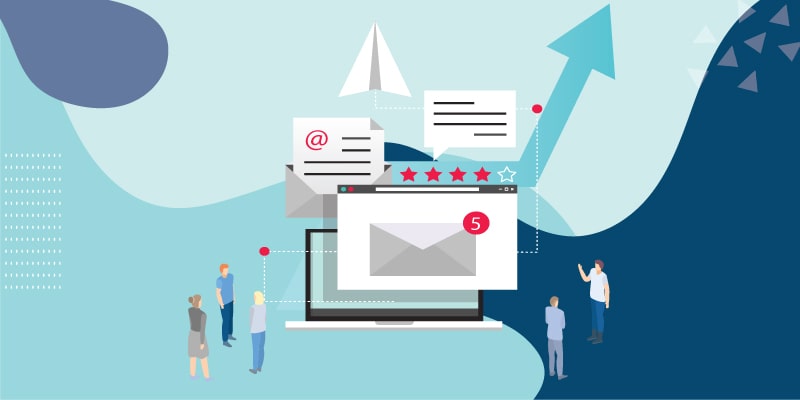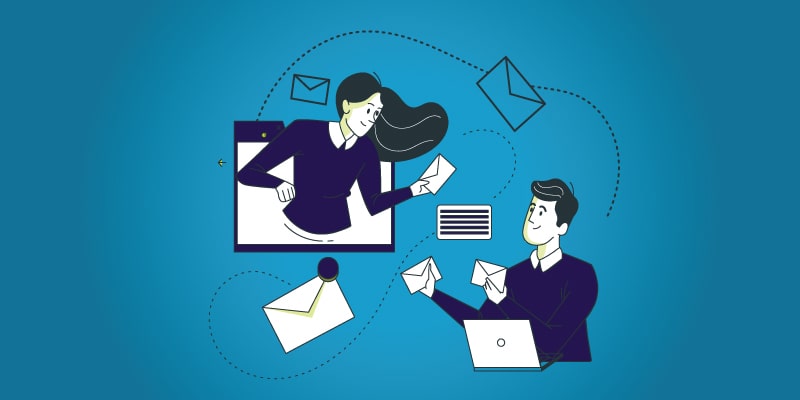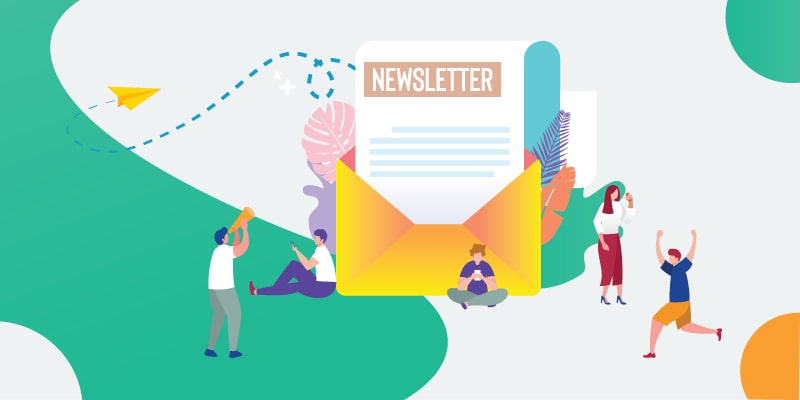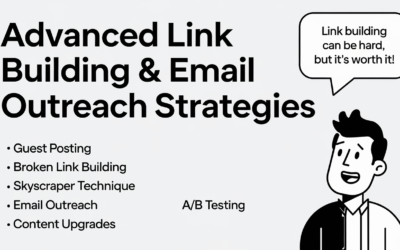What is Email Newsletter? And How To Create It?
Newspapers are one of the oldest forms of spreading the news about happenings across the world. So are the emails, which are the oldest form of digital communication. But, email newsletters are something that the brands have started using just a few years ago.
If we count it briefly, email newsletters are digital newspapers that help spread information and updates about the company. Over 70% of businesses use emails as a source of communication with users. Before knowing how to create an online newsletter, you need to know its importance.
Importance of email newsletter for the business

The email newsletters are quite essential and hold a significant place in email marketing because of the following:
- Massive audience: You can reach an enormous audience just with a few emails, and that too quickly. On average, each day, over 250 billion emails are sent and received. These figures are enough to justify its reach.
- Return on investment (ROI): This is achieved through prudent financial management, where minimizing costs and maximizing returns create a highly favourable situation. Meticulously crafted investment newsletters have the potential to significantly contribute to the success of not only marketing efforts but the entire business.
- Personalization: With email newsletters, you can meet the expectations of customers across various segments. Customization is based on behavioural analysis and customer preferences. It makes it likely that consumers interact with these emails and have positive outcomes.
- Relationship: In every business aspect, customers must trust the brand. With the overwhelming competition, it becomes even more important to be genuine with your customers. The email newsletters offer an excellent way to do that.
The purpose that email newsletters serve

No, email newsletters aren’t always about promotion. They are about building brand awareness and customer loyalty through the provision of valuable content.
The online newsletters that brands send serve some goals, which include:
- Bringing in the audience: Before moving on to lead generation, reaching a good number of the target audience is important. In online newsletters that have sent, you can attach the link to a relevant blog post, product, video, etc., whatever is the best by using segmentation.
- Brand recognition and awareness: There are times when a customer is eagerly looking for content and sending the relevant content. They will wait anxiously for the next email to show up in your inbox. Further, they start associating the content with your brand name, increasing awareness about your presence. It is where you reach the goal of being recognized by the target audience.
- Increase in sales: Along with non-commercial purposes that online newsletters serve, they are also an indirect method to increase sales. Suppose, by sending a case study of your brand’s success, you are giving credibility to the brand. Along with this, you are giving reasons to the audience of how your brand overpowers the others.
- Promotion of social media profiles: The social media profiles add worth to the brand. The more reach, the better is the engagement with the audience. With email newsletters, you can influence the audience to be a part of the social media community.
How to create an email newsletter

Once you’ve decided that you want to integrate email newsletters as a part of email marketing, you need to know how to create it. However, one thing to remember is that you send them to those who have agreed for newsletter sign-up. You can get going and create an effective online newsletter for newsletter sign-up with the following points:
- Figure out your goals and the data: The foremost question you have to ask before framing the newsletter is “Who?”. Who will receive the newsletter, the segmentation, and their preferences? Along with the audience, you need to define the company’s goals and what you expect after sending out the newsletter. It can be lead generation, increasing sales, or just engagement with the audience. Additionally, do not forget to consolidate the database into one file for smoother operations.
- Plan the schedule for the newsletter: You cannot keep spamming the user’s inbox every day. You need to streamline and figure a schedule for the content. One of the effective ways to do this is knowing the answer to three basic words, “What?”, “When?” and “Whom?”. Plan what you want to send, so you are all ready to get going. Thie even avoids missing out on broadcasting important events and updates about the brand.
- Gather the content: You can’t just send, “Hey! What’s up?”. Emails are a professional way of interaction, which makes it necessary to send out relevant content. Putting together requires a lot of active searching to fit nicely with the customer’s expectations. Further, with marketing automation, it is a good idea to personalize the content. However, you need not spend hours altogether to hunt content. You can find a lot of it through social media, blogs, and other sources and just bookmark the things right away.
- Design the email newsletter template: All those subscribers who are a part of the newsletter sign-up have certain expectations. No, it doesn’t mean you have to fit in many elements. But instead, they have a minimal design that is easy to read and comprehend. Additionally, you can add CTA buttons in the design to increase user-reach. In case you doubt your designing skills, there are always numerous email templates to choose from across the web.
The design variables to include in the email are:- Sender’s name, subject line, and header
- The layout of the email
- Brand logo
- CTA buttons
- Images, fonts, and color-scheme
- Spacing and background
- The integrity of the brand design
- Adjust the size of the email newsletter: You surely won’t read an email that is too long. It is important to size the emails to increase compatibility. Usually, the standard width of the newsletter is 600 px. Ensure that the design you choose fits in size.
- Body content: This is the most important part of the email. Spend enough time to curate it for the utmost perfection. Keep it clear and concise. Do not forget to add more images, as these surely get more attention. Once done and sent, you cannot edit or undo it. So, proofread and organize it well to avoid any mistakes or typos.
- Add in personalization and social media tokens: Online newsletters are not just limited to a single platform. Try to engage the newsletter sign-up across all platforms by adding cross-links; social media handles, among others, for increasing the relevance of the email.
- Add the subject line wisely: You don’t want your mail to land up in the spam section and look like just another promotional email. To increase the click-through rates and conversions, make the subject line worthy. On and off, you can use A/B testing to understand the audience’s preferences.
- At last, always follow these practices:
- Obey the laws and ensure that the mail you send is legal. The two primary laws which ensure the relevance of your mail are:
- CAN-SPAM
- GDPR
- Do not spam or over-communicate with the subscribers. Maintain a decent gap in the email timeline.
- Obey the laws and ensure that the mail you send is legal. The two primary laws which ensure the relevance of your mail are:
- Send it: Once you’ve created and followed those mentioned above, you are ready to hit the send button. After sending it, wait for a few days before the results of these emails roll in.
- Analysis: The last, but most important, is to track and understand how efficiently the email newsletters worked. If it has a positive response, then you can further add features and implement them by iterating the same procedure. However, if the response is unfavorable, you will have to revamp the strategies according to the expectations.
You can also use marketing automation techniques to have a precise idea of the data. With all other technologies, you can also find which area of the email has got the most response and which one is lagging. The closed-loop analytics is also a great way to gain insights.
Conclusion
To summarize, you can follow these practices for good conversions and engagement with the audience. Try not to overload content in your mails, making the users unsubscribe from the emails. If a user has agreed for newsletter sign-up, it is an indication that they are interested in the brand.
All you have to do is convince them and build a proper brand identity. With all the technologies, including available marketing automation, you can set-up your email marketing strategy within a few clicks. Even though emails are decades old, they still are quite significant in the marketing world. If you are dicey about where to start your marketing from, emails are the way to go.
Define your business goals and engage with the audience. So, what are you waiting for? Go and put all the consumer data present in the excel spreadsheets to good use!
Also Read:


